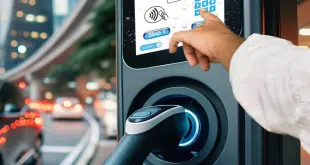By John Stewart
Larger screens, buy buttons, and streamlined checkouts are expected to combine to raise the profile of smart phones in e-commerce. And now there are numbers to show just how much retail sales volume the devices will generate.
Smart phones will account for $27.7 billion in retail mobile commerce this year, a 38% increase over 2014, according to eMarketer Inc., a New York City-based market-research firm. That number will grow another 32% in 2016 to reach $36.6 billion, eMarketer projects. And by the end of 2019, commerce performed on smart phones will be responsible for nearly $41 billion in annual retail sales, the firm predicts, good for a touch more than 40% of all retail mobile commerce.
“Fewer people are putting down the phone to make a purchase using another device. Consumers are opting to complete their transaction with the same device they began the shopping journey with, and that is increasingly with a smart phone,” said Monica Peart, an eMarketer analyst, in a blog post about the projections.
The research firm cites several reasons for that, including larger device screens and the recent introduction of buy buttons on retail sites and on popular social-media networks like Facebook and Pinterest. These two sites among all social-media networks refer the most traffic to retailer sites, according to eMarketer.
Buy buttons, which import product information from retail sites and streamline purchases for users, have gained traction in recent months as technology companies introduce application programming interfaces (APIs) to ease integration with merchants’ back-office operations.
XpressBuy Inc., for example, recently announced four large e-commerce platforms had integrated its buy-button technology. And this week a rival company, PredictSpring, launched a platform that allows buyers to make purchases with a single click using Apple Pay.
Indeed, single-click checkouts may do more than anything else to drive up commerce on smart phones, since they purport to eliminate the tedious chore of entering billing and shipping data on small screens. The technology, which relies on stored data including card credentials, promises to increase sales by improving what have been dismal conversion rates on mobile devices.
This week, both Visa Inc. and PayPal Holdings Inc. made news with developments related to their single-click efforts. PayPal has extended its One Touch technology to 13 new markets in Europe and Australia, going beyond the U.S., U.K., and Canada. Half of the 100 largest e-commerce merchants are now enabled for One Touch, along with “millions of consumers,” PayPal says.
Visa meanwhile says its Visa Checkout service, introduced a year ago, is now available in 16 countries, with four new markets announced this week. The service claims 6 million registered users, with a 92% rise in registrations since the start of the year.
Visa released numbers this week showing a 69% conversion rate for customers using Visa Checkout, a 66% improvement over what the company calls “traditional checkout.” The numbers come from a study commissioned by Visa and conducted by researcher comScore Inc. using a panel of 1 million PC and laptop users in the U.S.
Both digital wallets relieve consumers of the chore of tapping out data on mobile screens. Unlike PayPal’s One Touch checkout, however, Visa Checkout (as well as MasterCard Inc.’s competing MasterPass wallet) does require a password.





